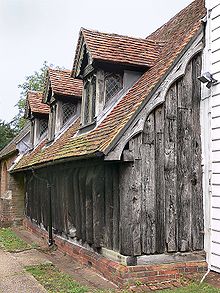- Greensted Church
-
Greensted Church, in the small village of Greensted, near Chipping Ongar in Essex, England, is the oldest wooden church in the world[1], and probably the oldest wooden building in Europe still standing, albeit only in part, since few sections of its original wooden structure remain. The oak palisade walls are often classified as remnants of a palisade church or a kind of early stave church, dated either to the mid-9th[2] or mid-11th century.
The church lies about a mile west of Chipping Ongar town centre. Its full title is The Church of St Andrew, Greensted-juxta-Ongar. It is, however, commonly known simply as Greensted Church to locals and tourists alike. Greensted is still a functioning church and holds services every week. The volume of tourist visits is light, but steady.
Contents
History
 A stained glass window depicting St Edmund, visible inside the church.
A stained glass window depicting St Edmund, visible inside the church.
Greensted Church has been situated in its idyllic setting for nearly 1,200 years. And archaeological evidence suggests that, before there was a permanent structure, there may well have been another church, or a holy place, on the site for much longer, possibly dating back to around the 4th century.
Construction of the first permanent church on this site is thought to have begun shortly after St. Cedd began his conversion of the Saxon people around 654. The archaeological remnants of two simple wooden buildings were discovered under the present chancel floor, and these are thought to have been built in the late sixth or early 7th century.
The church's dedication to St. Andrew suggests a Celtic foundation for the original sanctuary. The body of King Edmund of East Anglia (who died in 870 at Hoxne) is said to have rested there in 1013, on its way to reburial at Bury St Edmunds.
Construction
An interesting detail is the so-called "Leper's Squint" on the north side. This small aperture through the oak wall was formerly thought to have been a place where lepers who, not allowed inside the church with the general populace, were allowed to receive a blessing from the priest. It is now believed to be a holy water stoup.
The church, like many, has had additional work performed on it over the centuries.
Anglo-Saxon and Norman elements
The nave is mostly original, and dendrochronological research in the 1960s dated it to 845. In 1995, however, this date was revised to 1053 +10 -55 years (sometime between 998 and 1063).[3] It is made of large split oak tree trunks, which was a traditional Saxon form of construction. The flint footings of the chancel wall and the pillar piscina inside the sanctuary are all that remain of any identifiably Norman work.
1500s
Henry VII's reign saw many changes to England, and they are reflected in the changes made to the church at this time. The original chancel was small and built of timber, but the current brick-built chancel dates from this period of construction.
1600–1800
The distinctive white wood-panelled tower was added in the Stuart period (17th century), and is what initially draws the eye. One of the bells is inscribed "William Land made me 1618", and so many consider the tower may in fact have been built earlier. This would not be too surprising as there are a number of mediaeval wooden towers in the district.
Around this time the three dormer windows were added to the nave for the first time, and the south porch was added. A fragment of 15th–century glass can be seen in the centre of the quatrefoil window at the west end, but it was set there during the Victorian restoration. The earliest wall memorial is dedicated to Jone Wood, 1585.
Victorian restoration
Reconstruction work by the Victorians in the 19th century added some wonderfully detailed brickwork to the building along with, most probably, some of the more ornate decoration to the outside.
Specifically it replaced the 3 dormer windows with 6, and the porch was also reconstructed, along with other minor alterations and stone coping.
Notable events
In 1013 an ancient chronicler records that the body of St Edmund was, for a night, deposited at Greensted Church. There are many tributes to St Edmund in the church itself.
Also, near the porch, a large, flat, coped stone marks the quiet resting place of an unknown early crusader who is said to have arrived, badly wounded, at the church and died there. The fact that it was made of stone, not a local material, and was placed against the south wall, suggests he was considered as a hero.
The Tolpuddle Martyrs were granted farm tenancies in the area after they were unable to return to their Dorset homes and the record of marriage of one of them, James Brine, can be seen in the present register.
References
- ^ Frewins, Clive. The Church Explorer's Handbook. Canterbury Press Ltd, 2005. ISBN 185311622X. Page 16.
- ^ Details from listed building database (117767) . Images of England. English Heritage.
- ^ Early church date, British Archaeology, no 10, December 1995: News
External links
- British Archaeology, no 10, December 1995: News
- http://www.essexchurches.info - Greensted Church on Essex Churches website
- Everything2 article: St Andrew's, Greensted-juxta-Ongar
- Internet Archive of the former website: www.greenstedchurch.com
- MSN Encarta: Anglo-Saxon Art and Architecture (Archived 2009-10-31)
- Virtual Photography: St. Andrew's Church
Categories:- Church of England churches in Essex
- Epping Forest
- Grade I listed buildings in Essex
- Grade I listed churches
- Stave churches
- 11th-century church buildings
- Standing Anglo-Saxon churches
Wikimedia Foundation. 2010.


